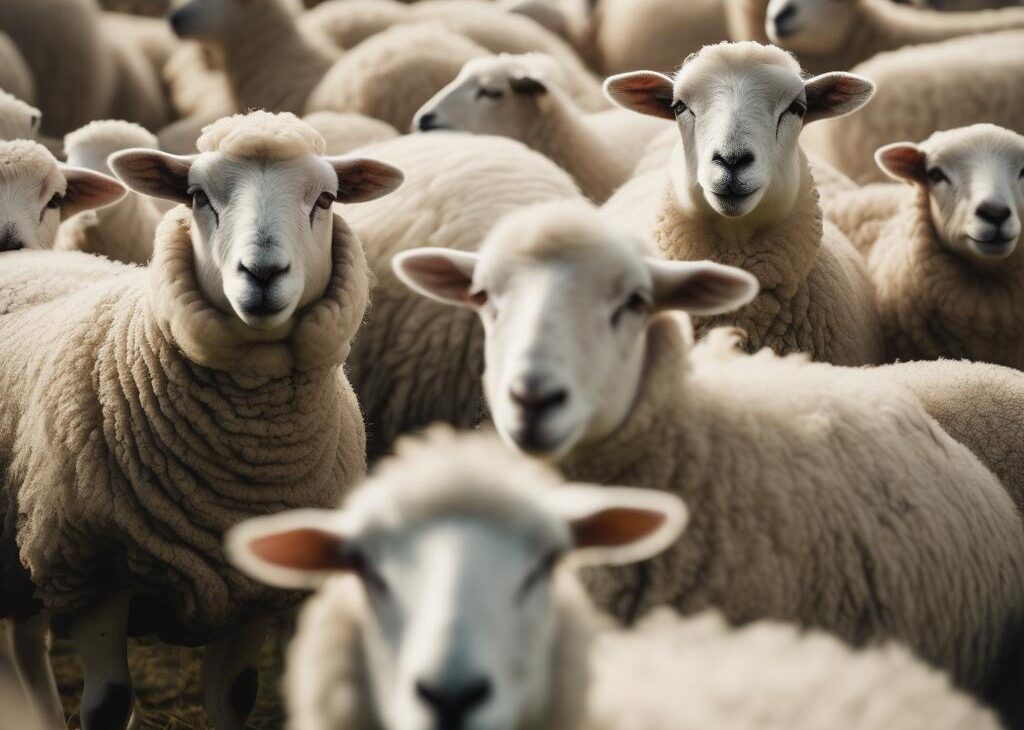-
Table of Contents
- A Group of Sheep is Called: Exploring the Fascinating Terminology of Sheep Herds
- The Basics: What is a Group of Sheep Called?
- The Social Nature of Sheep
- The Size of Sheep Flocks
- Sheep Herding and the Role of Shepherds
- FAQs: Answering Common Questions About Sheep Herds
- 1. How many sheep are typically in a flock?
- 2. Do sheep always stay together in a flock?
- 3. How do shepherds control large flocks of sheep?
- 4. Can sheep recognize their shepherd?
- 5. How far can sheep roam from their flock?
- Conclusion
Sheep, those fluffy and gentle creatures, have been domesticated for thousands of years and have played a significant role in human civilization. Whether you are a farmer, a nature enthusiast, or simply curious about the animal kingdom, you may have wondered what a group of sheep is called. In this article, we will delve into the captivating world of sheep herds, exploring their terminology, behavior, and the importance of these social animals.
The Basics: What is a Group of Sheep Called?
Before we dive deeper into the topic, let’s answer the fundamental question: what is a group of sheep called? The answer is a flock. Yes, a flock of sheep is the commonly used term to describe a group of these woolly creatures. However, the size of a flock can vary significantly, ranging from just a few individuals to hundreds or even thousands of sheep.
The Social Nature of Sheep
Sheep are highly social animals that thrive in groups. They have a strong instinct to flock together, which has been ingrained in their behavior through centuries of domestication. Living in a flock provides numerous benefits for sheep, including protection from predators, improved foraging opportunities, and enhanced social interactions.
Within a flock, sheep establish a hierarchical structure based on dominance. This hierarchy is often determined by age, size, and strength. The dominant sheep, known as the “alpha” or “top” sheep, typically leads the flock and makes decisions regarding movement, grazing areas, and other activities.
The Size of Sheep Flocks
Sheep flocks can vary greatly in size, depending on various factors such as the breed, geographical location, and farming practices. Let’s explore some examples of different-sized sheep flocks:
- Small Flocks: Some farmers or hobbyists may keep small flocks of sheep, ranging from just a handful to around 50 individuals. These smaller flocks are easier to manage and require less space and resources.
- Medium-Sized Flocks: In many agricultural settings, medium-sized sheep flocks are common. These flocks can consist of anywhere from 50 to a few hundred sheep. They require more extensive grazing areas and additional management efforts.
- Large Flocks: In certain regions, particularly in extensive grazing systems or countries with vast pastoral lands, large sheep flocks can be found. These flocks can comprise several hundred to thousands of sheep. Managing such large numbers requires specialized skills and infrastructure.
Sheep Herding and the Role of Shepherds
Sheep herding, the act of guiding and managing a flock of sheep, has been practiced for centuries. Shepherds play a crucial role in ensuring the well-being and productivity of the flock. They use various techniques, including the use of trained herding dogs, to move and control the sheep.
Shepherds employ their knowledge of sheep behavior and instincts to guide the flock in the desired direction, prevent straying, and protect them from potential dangers. The relationship between a shepherd and their flock is often built on trust and understanding.
FAQs: Answering Common Questions About Sheep Herds
Now, let’s address some frequently asked questions about sheep herds:
1. How many sheep are typically in a flock?
The size of a sheep flock can vary significantly. It can range from just a few individuals to several thousand, depending on factors such as farming practices, geographical location, and breed.
2. Do sheep always stay together in a flock?
Sheep have a strong instinct to stay together in a flock. However, individual sheep may occasionally wander away or become separated from the group. This behavior is more common in larger flocks or when sheep are exposed to unfamiliar environments.
3. How do shepherds control large flocks of sheep?
Shepherds use various techniques to control large flocks of sheep. These may include the use of trained herding dogs, whistles, and verbal commands. Shepherds rely on their understanding of sheep behavior and instincts to guide the flock in the desired direction.
4. Can sheep recognize their shepherd?
Sheep have the ability to recognize individual humans, including their shepherd. They can distinguish familiar faces and voices, which helps in building a bond of trust between the shepherd and the flock.
5. How far can sheep roam from their flock?
The distance that sheep can roam from their flock depends on various factors, including the size of the flock, the availability of resources, and the presence of predators. In general, sheep tend to stay within a relatively close distance to the flock, but individual sheep may occasionally wander further away.
Conclusion
A group of sheep is called a flock, and these social animals thrive in the company of their fellow woolly companions. Whether it’s a small flock tended by a hobbyist or a large flock managed by a skilled shepherd, sheep demonstrate their instinctual behavior and hierarchical structure within these groups. Understanding the terminology and dynamics of sheep herds provides valuable insights into the fascinating world of these gentle creatures.
Next time you spot a flock of sheep grazing peacefully in a meadow, take a moment to appreciate the intricate social bonds and cooperative nature that allow them to thrive as a group.




